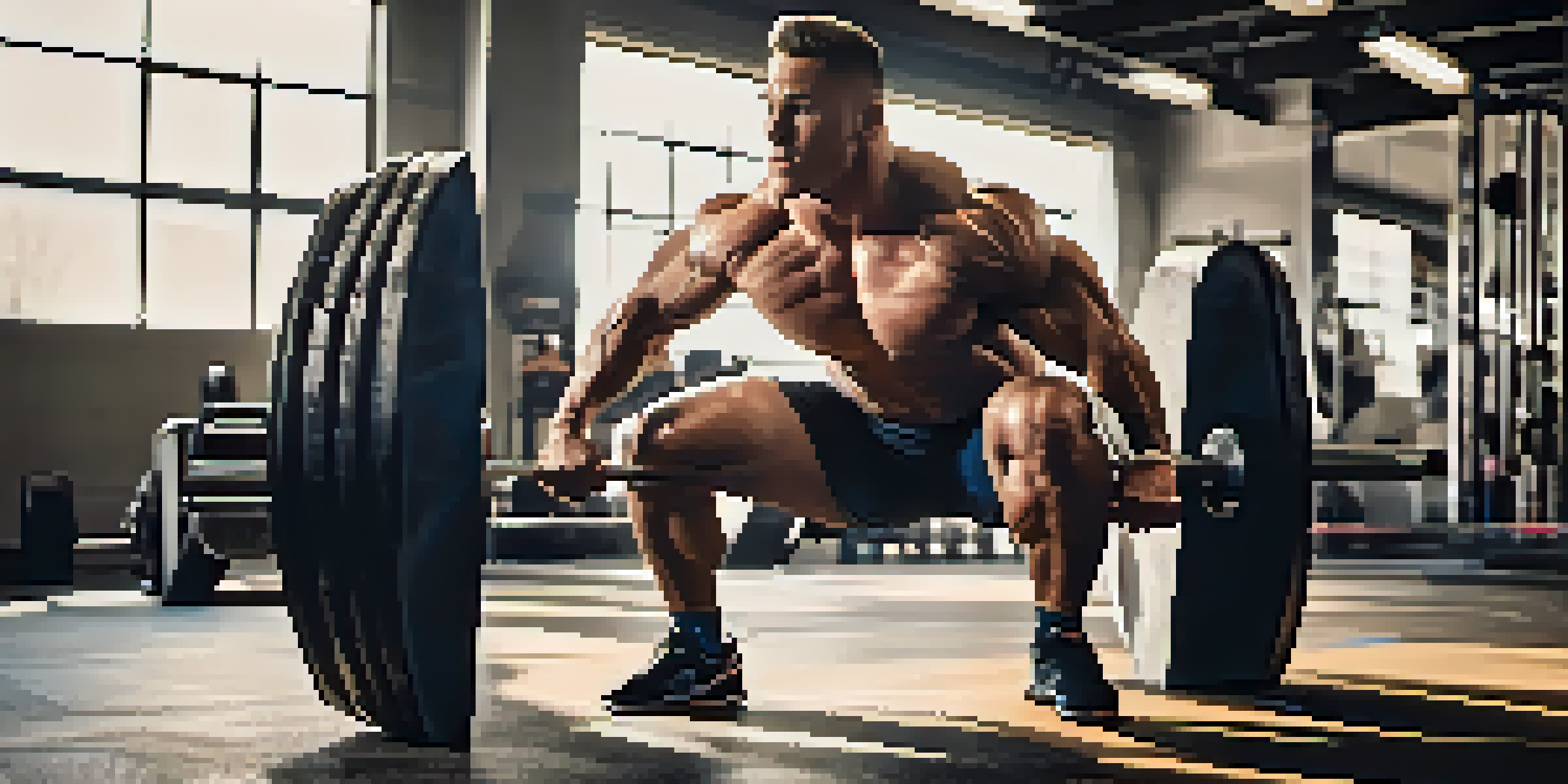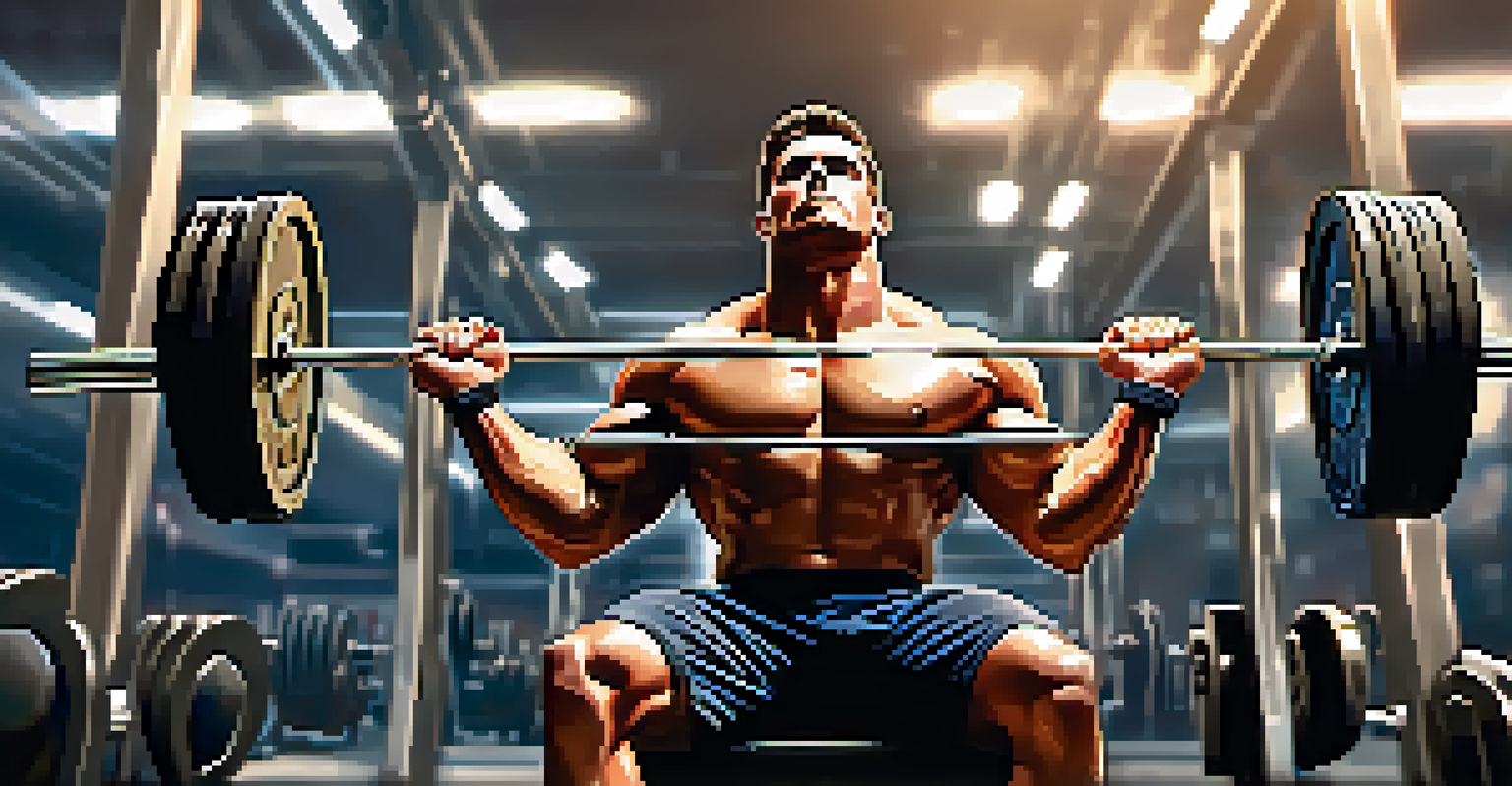Powerlifting Fundamentals: Building Strength for All Sports

Understanding Powerlifting and Its Benefits
Powerlifting is more than just lifting heavy weights; it’s about building foundational strength that benefits athletes across all sports. At its core, powerlifting focuses on three main lifts: the squat, deadlift, and bench press. These compound movements engage multiple muscle groups, promoting overall strength and stability.
Strength does not come from physical capacity. It comes from an indomitable will.
For athletes, incorporating powerlifting techniques can lead to enhanced performance, improved endurance, and even injury prevention. By developing core strength and functional movement patterns, athletes can perform better in their respective sports. Think of it as building a sturdy house; without a solid foundation, the structure can easily crumble under pressure.
Additionally, powerlifting teaches discipline and dedication, qualities that are transferable to any sport. Athletes who commit to a powerlifting routine often find themselves more resilient, both physically and mentally, ready to tackle the demands of their sport.
The Importance of Proper Technique in Powerlifting
Technique is crucial in powerlifting, as improper form can lead to injuries and decreased performance. Each lift has its unique mechanics, and mastering these is essential for lifting safely and effectively. For instance, during a squat, keeping your knees in line with your toes ensures optimal alignment and reduces strain on your joints.

Practicing good technique not only enhances strength gains but also builds muscle memory. This muscle memory is invaluable when athletes transition to their sport-specific movements. It’s akin to learning to ride a bike; once you grasp the fundamentals, you can navigate various terrains with ease.
Powerlifting Builds Foundation Strength
Powerlifting enhances overall athletic performance by focusing on fundamental lifts that promote strength and stability.
Moreover, focusing on technique helps athletes understand their bodies better. By becoming aware of how each movement feels, athletes can make necessary adjustments, leading to improved performance in their sports. Ultimately, good technique lays the groundwork for lifelong strength training.
Key Powerlifting Movements and Their Applications
The three primary lifts in powerlifting—squat, bench press, and deadlift—each offer unique benefits that translate well into athletic performance. The squat builds leg strength and power, essential for sports that require explosive movements, like sprinting or jumping. This foundational strength can help athletes push through their limits and improve their overall game.
The only way to prove that you are a good sport is to lose.
The bench press primarily targets the upper body, enhancing pushing strength vital for sports like football or basketball. Strong chest, shoulder, and tricep muscles contribute to more powerful throws and blocks, allowing athletes to gain an edge over their competitors. Think of it as adding horsepower to your engine; the more power you have, the faster you can go.
Finally, the deadlift is a fantastic full-body exercise that develops posterior chain strength, which is crucial for maintaining proper posture and preventing injuries. For athletes, a strong back and hamstrings mean better stability and endurance during play. By incorporating these movements, athletes can reap the rewards of powerlifting in their chosen sports.
Creating a Powerlifting Routine for Athletes
Designing a powerlifting routine tailored to athletes involves selecting the right exercises and determining appropriate volume and intensity. Athletes should aim for 2-3 powerlifting sessions per week, focusing on their main lifts along with accessory exercises that target weak points. For example, if an athlete struggles with their squat, incorporating assistance exercises like lunges can help improve their performance.
Another key aspect is periodization, which involves varying training intensity and volume over time. This approach helps prevent plateaus and keeps training fresh and engaging. Think of it like a roller coaster ride; the ups and downs keep you on your toes and make the experience enjoyable.
Technique is Key to Safe Lifting
Proper technique in powerlifting is essential to prevent injuries and maximize strength gains, aiding in sport-specific movements.
Additionally, athletes should prioritize recovery and listen to their bodies. Incorporating rest days and active recovery sessions helps in muscle repair and growth. A well-structured routine balances hard work with adequate recovery, ensuring athletes remain strong and injury-free.
Nutrition: Fueling Your Powerlifting Journey
Nutrition plays a vital role in powerlifting and overall athletic performance. Athletes need to fuel their bodies with nutrient-dense foods that support intense training sessions. A balanced diet rich in protein, healthy fats, and carbohydrates provides the energy needed for optimal performance.
For instance, consuming protein-rich foods like chicken, fish, and legumes can aid in muscle recovery and repair. Carbohydrates, such as whole grains and fruits, provide the necessary energy for workouts. It’s like filling up your gas tank before a long drive; without the right fuel, you won’t get far.
Hydration is equally important, as even mild dehydration can affect strength and performance. Athletes should aim to drink plenty of water throughout the day and consider electrolyte-rich drinks during intense training sessions. By prioritizing nutrition and hydration, athletes can maximize their powerlifting gains and athletic performance.
The Role of Mental Toughness in Powerlifting
Mental toughness is a crucial component of powerlifting that often goes unnoticed. It involves pushing through discomfort, overcoming self-doubt, and maintaining focus during training and competitions. Developing mental resilience can help athletes not only in the gym but also in their respective sports.
Visualization techniques can be particularly beneficial; imagining successful lifts can enhance confidence and performance. Many athletes find that picturing themselves completing a lift can reduce anxiety and improve execution. It’s similar to rehearsing for a play; the more you visualize your role, the more comfortable you become on stage.
Nutrition Fuels Powerlifting Success
A balanced diet and proper hydration are crucial for athletes to support their powerlifting training and enhance performance.
Moreover, setting realistic goals can foster a positive mindset and drive progress. By breaking down larger objectives into smaller, achievable milestones, athletes can celebrate their progress along the way. This approach helps maintain motivation and reinforces the belief that they can accomplish their goals, both in powerlifting and their sport.
Incorporating Powerlifting into Your Training Regimen
Integrating powerlifting into an athlete’s training regimen can be a game-changer for performance. Start by assessing current strength levels and identifying areas for improvement. This assessment will help tailor a powerlifting program that complements existing training while addressing specific needs.
It’s essential to communicate with coaches or trainers to ensure that powerlifting sessions align with overall training goals. For example, if an athlete is in the middle of a competitive season, adjustments may be necessary to avoid burnout. Think of it as adjusting the sails on a boat; the right tweaks can help steer you in the right direction.

Lastly, consistency is key. Athletes should commit to their powerlifting training and make it a regular part of their routine. Over time, this dedication will lead to significant strength gains and improved performance in their primary sport, ultimately helping them become more well-rounded athletes.